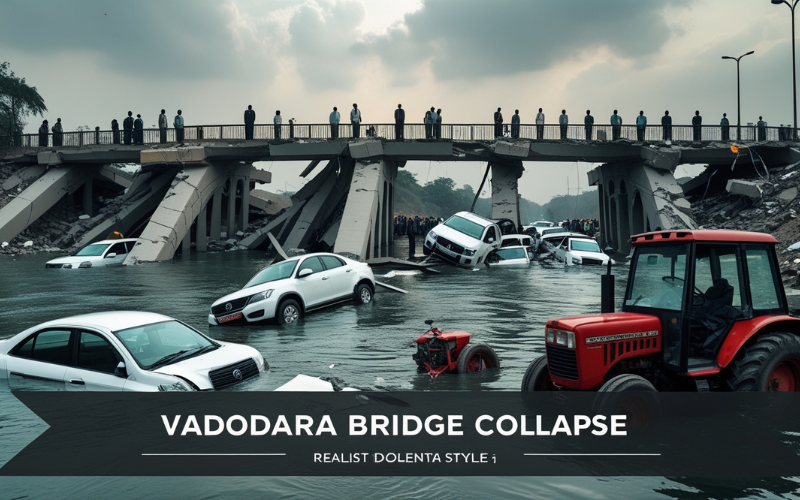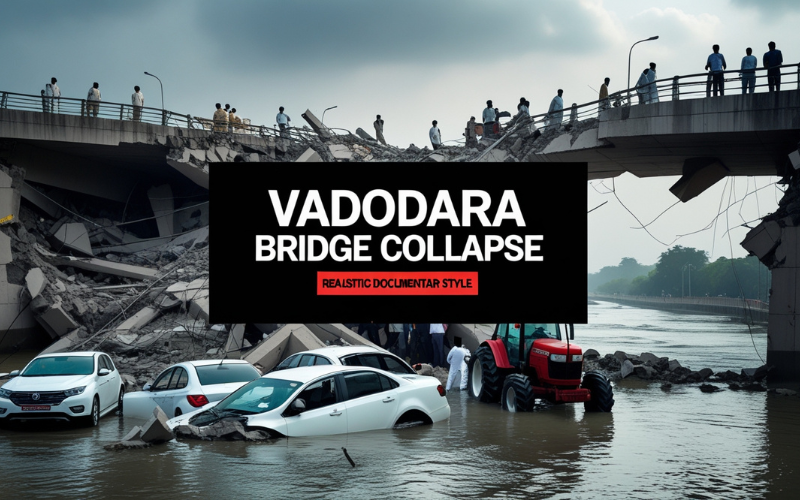Tragedy in Gujarat: Vadodara Bridge Collapse Claims 9 Lives, Sparks National Mourning

In a devastating turn of events that shook Gujarat and the nation, the Vadodara bridge collapse on Sunday evening led to the deaths of at least nine people, with multiple vehicles plunging into the Mahisagar river. The bridge, part of the Padra-Mujpur connector, gave way unexpectedly, causing chaos and tragedy that unfolded in seconds. Authorities have confirmed the fatalities and have launched a rescue and investigation operation. Prime Minister Narendra Modi has expressed grief and announced an ex-gratia amount of ₹2 lakh to the families of each victim, reinforcing the severity and national importance of the tragedy.
Panic Unfolds as Vadodara Bridge Collapse Sends Vehicles into Mahisagar River
The Vadodara bridge collapse occurred around 5:30 PM, just as traffic on the Padra-Mujpur bridge had picked up pace during the evening rush hour. Eyewitnesses reported hearing a loud rumble followed by screams and chaos as four vehicles, including a private car and autorickshaws, crashed into the turbulent river below. Rescue teams rushed to the scene, working tirelessly to recover survivors and retrieve the bodies of the deceased. Visuals from the accident site showed mangled remains of vehicles and anxious family members gathering in panic.
Local residents have long complained about the structural vulnerabilities of the Padra-Mujpur bridge, but many feel their concerns were never taken seriously. The Vadodara bridge collapse has now become a grim reminder of how poor infrastructure and delayed maintenance can result in catastrophic outcomes. State officials, including Chief Minister Bhupendra Patel, have visited the site and promised stringent action against negligence.
Vadodara Bridge Collapse Triggers Massive Rescue and Recovery Efforts
As the sun set over Vadodara, rescue teams from the National Disaster Response Force (NDRF), State Disaster Response Force (SDRF), and local police continued their efforts under floodlights. The Gujarat Fire and Emergency Services deployed divers, boats, and heavy lifting equipment to assist in recovering the submerged vehicles and locating any survivors trapped in the riverbed. The Vadodara bridge collapse is being seen as one of the deadliest infrastructure disasters in recent times in the region.
Hospitals across Vadodara, including SSG Hospital, were placed on high alert, and emergency services worked round the clock. Survivors who were rescued recounted their horrifying ordeal—many of them were simply returning home from work or shopping. A local rickshaw driver, who narrowly escaped, described the moment the bridge shook violently and then split, sending vehicles crashing down.
National Shock and Mourning Over the Vadodara Bridge Collapse
Prime Minister Narendra Modi, who hails from Gujarat, expressed deep sorrow over the incident. His office issued an official statement: “The Vadodara bridge collapse is a painful tragedy. I am deeply anguished by the loss of lives and have directed officials to provide all necessary aid to those affected.” The ₹2 lakh ex-gratia announced by PM Modi will be provided from the Prime Minister’s National Relief Fund (PMNRF), while the Gujarat government has announced additional compensation.
Union Home Minister Amit Shah and Gujarat Governor Acharya Devvrat also shared their condolences and urged for a time-bound investigation into the causes of the Vadodara bridge collapse. Meanwhile, political parties in the opposition have criticized the state government for its failure to audit and repair old infrastructure, calling the tragedy a result of “institutional apathy and administrative failure.”
Infrastructure Crisis: Vadodara Bridge Collapse Sparks Fresh Concerns
The Vadodara bridge collapse has reignited a nationwide debate on the state of India’s aging infrastructure. Structural engineers and experts from across the country are calling for urgent audits of all old bridges, especially those over rivers. The Padra-Mujpur bridge, built decades ago, had been subjected to heavy traffic over the years. However, according to several reports, no proper maintenance or reinforcement had been conducted recently.
Many fear that the Vadodara bridge collapse may be just the beginning if preventive measures are not taken immediately. In 2022, the collapse of a suspension bridge in Morbi, Gujarat, had killed 135 people. That memory is still fresh in the minds of citizens, and the latest disaster has only added to the trauma. With monsoons further weakening existing infrastructure, experts warn that more such incidents could occur if proactive inspections are not enforced.
Emotional Aftermath: Families Devastated by the Vadodara Bridge Collapse
For the families of the deceased, the Vadodara bridge collapse has left an irreparable void. Mourning rituals have begun in several villages and towns from where the victims hailed. Emotional scenes were witnessed at the local hospitals and cremation grounds. The local administration is providing grief counseling and logistical support to the bereaved families.
Among the victims were two schoolteachers, a newly married couple, and a 7-year-old child. Their stories have made the incident even more heartbreaking. Local media channels have been covering these stories around the clock, amplifying public outrage and empathy. As public grief turns to anger, calls for accountability grow louder.
Will the Vadodara Bridge Collapse Bring Lasting Policy Reforms?
There is growing pressure on the Gujarat government to take decisive action following the Vadodara bridge collapse. Several civic bodies have already started emergency inspections of bridges and flyovers across Vadodara and neighboring districts. The Indian Roads Congress (IRC) and Central Public Works Department (CPWD) are likely to be brought in to provide technical audits and solutions.
A Public Interest Litigation (PIL) has already been filed in the Gujarat High Court, seeking judicial monitoring of the investigation into the Vadodara bridge collapse. Legal experts believe that unless criminal negligence is proven and punished, such incidents will continue. Citizens’ groups are also organizing candlelight marches and awareness campaigns to push for policy reforms and better civic accountability.
As more details emerge about the history, maintenance records, and construction quality of the collapsed bridge, the story of the Vadodara bridge collapse is expected to remain in public discourse for weeks. For now, Vadodara mourns its dead, and India once again grapples with the painful consequences of neglected infrastructure.
Public Reactions and Political Heat Intensify After Vadodara Bridge Collapse
In the aftermath of the Vadodara bridge collapse, political debates have escalated at both the state and national levels. Opposition parties have called for a judicial probe, accusing the current administration of neglect and corruption in infrastructure development. Former Gujarat Chief Minister Shankersinh Vaghela demanded that an independent technical committee be formed to probe the incident.
Citizens, too, have begun voicing their anger on social media platforms. Hashtags like #VadodaraBridgeCollapse and #GujaratNegligence have trended nationwide. Videos showing the moments after the collapse have gone viral, stirring emotions and prompting thousands to demand answers and reform.
In Vadodara, locals have started forming neighborhood safety groups to monitor bridge conditions and report issues. Social activists have begun petitions asking the central government to release a white paper on India’s bridge safety protocols. The Vadodara bridge collapse has become a symbol of both tragedy and the urgent need for change.
Expert Opinions: How the Vadodara Bridge Collapse Can Reshape Safety Audits

Structural engineers are unanimous in their assessment—aging bridges across India are in dire need of comprehensive audits. In interviews conducted post-collapse, several experts noted that visual inspections alone are not enough. Many of India’s bridges lack seismic reinforcement and are poorly maintained, which contributes to disasters like the Vadodara bridge collapse.
Dr. Rajesh Mehta, a senior civil engineer from IIT Gandhinagar, commented: “Bridges like the one in Padra-Mujpur were never meant to handle today’s traffic density. Without retrofitting, their collapse is just a matter of time.” His warning echoed through national media, further emphasizing the need for timely intervention.
A Nation at Crossroads: Learning from the Vadodara Bridge Collapse
The Vadodara bridge collapse has become more than a local incident—it’s a national wake-up call. Urban planners, civil engineers, and politicians agree that India cannot afford to ignore its aging infrastructure. The bridge that collapsed was symbolic of hundreds of such structures across the country.
In Parliament, lawmakers from multiple parties have called for a national bridge safety mission. Proposals include setting up a centralized database of bridge health status, mandatory annual inspections, and punishment for administrative negligence. Many hope that the loss of nine innocent lives will not be in vain.
From Vadodara to Delhi, the entire nation watches as investigations unfold. Citizens demand transparency, action, and most importantly—change. Because if the Vadodara bridge collapse does not lead to reform, it may not be the last of its kind.
Community Mobilization and the Call for Collective Action Post-Vadodara Bridge Collapse
In response to the Vadodara bridge collapse, local communities have begun mobilizing to ensure that such tragedies do not repeat. Volunteers are helping monitor aging bridges, gather reports, and petition local officials. Local NGOs are distributing educational material on infrastructure awareness and encouraging citizens to report cracks, rust, or vibration in nearby bridges.
Schools and colleges in Vadodara have launched awareness campaigns, engaging engineering students in simulated audits and surveys of smaller local bridges. Municipal authorities, though slow at first, have begun involving citizen committees to ensure transparency.
The incident has also encouraged regional authorities to hold emergency meetings to discuss infrastructure gaps, funding bottlenecks, and corruption in tendering processes. The Vadodara bridge collapse is becoming a case study in governance failure—but also a rallying point for systemic change.
Bridging the Future: National Lessons from the Vadodara Bridge Collapse
The tragic Vadodara bridge collapse must become a pivotal moment in India’s infrastructure narrative. Across the nation, engineers, bureaucrats, and civil society members are asking: What can we do to stop this from happening again? Central and state governments must now move from reactive measures to proactive infrastructure renewal.
The Ministry of Road Transport and Highways is reportedly considering a nation-wide bridge health registry—tracking age, repair history, inspection frequency, and risk assessments. If implemented effectively, this could help avert disasters. The Vadodara bridge collapse has the potential to become the catalyst India needed to finally prioritize infrastructure safety.
India’s bridges carry not just vehicles, but hopes, livelihoods, and lives. Each collapsed bridge is not just a structural failure—it is a failure of vision, governance, and responsibility. Let the memory of the Vadodara bridge collapse guide a safer, stronger future for India.
Rebuilding Trust and Infrastructure After the Vadodara Bridge Collapse
As news of the Vadodara bridge collapse continues to dominate headlines, one of the biggest challenges facing both the Gujarat government and the central administration is the restoration of public trust. Citizens are no longer content with condolences and ex-gratia payments—they demand lasting reforms and visible improvements in infrastructure monitoring.
Several local engineering colleges have taken the initiative to begin community audits, with students and faculty inspecting small bridges and flyovers within city limits. These citizen-led efforts are gaining momentum and public support. The Vadodara Municipal Corporation (VMC) has also committed to monthly structural health checks for 70 bridges in its jurisdiction.
The Vadodara bridge collapse has led to introspection not only within civil engineering departments but also within public administration training institutes. Many bureaucrats and planners are re-evaluating current maintenance tender procedures and exploring advanced technologies such as structural health monitoring systems (SHMS) and AI-driven analytics.
From drone surveillance to bridge vibration sensors, the tech sector has offered new tools to help ensure tragedies like the Vadodara bridge collapse are not repeated. Civil society and private sector partners have begun developing public dashboards showing maintenance schedules, inspection results, and risk levels of public infrastructure.
This tragedy has underscored the pressing need to treat bridge safety as a public priority and not merely a technical issue. Legislative reforms may be tabled in the coming months to institutionalize transparent, accountable, and data-driven infrastructure governance. The Vadodara bridge collapse must, and likely will, serve as the pivot for transformative change across India’s cities and towns.
The journey from grief to change has only just begun. What remains to be seen is whether this momentum will sustain and translate into real, measurable outcomes. For now, Vadodara stands as a symbol—of loss, yes—but also of hope for a more vigilant, responsible, and safe future.

